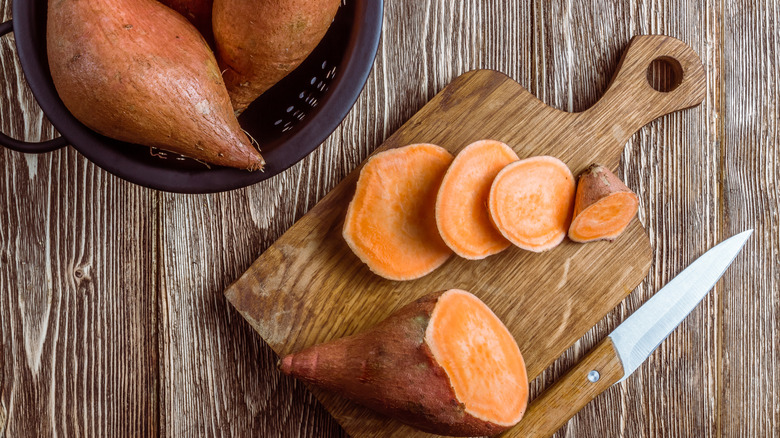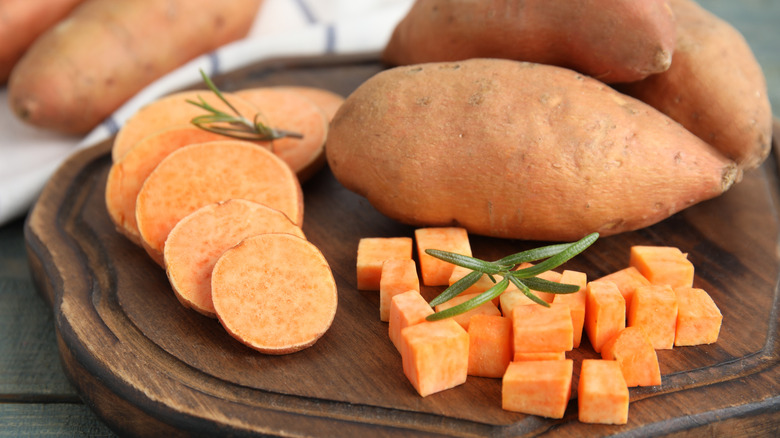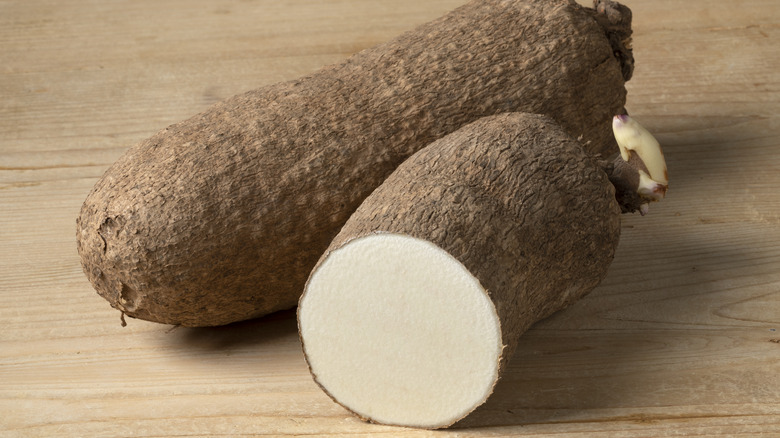No, Yams And Sweet Potatoes Aren't The Same Thing
For those who have always assumed that 'yam' is just another word for 'sweet potato,' and vice versa, we've got a surprise for you! These starchy root vegetables are actually two very different foods. You can't blame these people, however, especially in the United States, where the terms tend to be used interchangeably, even by produce suppliers and canned food producers who are actually well aware of the differences. The proof is on the labels of canned yams in the store; look closely at the small print on the front or at the ingredients list, and you'll see that the contents are actually cubes of sweet potatoes in a sugary syrup.
The name confusion began more than a century ago in the southern United States where sweet potatoes are widely grown. True yams are native to Africa and an important part of the dishes and culture of enslaved people brought to the southern states from African countries, according to the Library of Congress. Some varieties of sweet potatoes have a soft texture when cooked, one that resembles the texture of cooked yams. Slaves used sweet potatoes in ways they had traditionally used yams, and the two terms gradually came to be used to describe the same foodstuff.
Although they are sometimes mistaken for one another, once you know the difference between true yams and sweet potatoes, it's pretty easy to distinguish between the two.
The 411 on sweet potatoes
Even though they have "potato" in the name, sweet potatoes are not in the same family as common potatoes like russets and Idahoes. Sweet potatoes actually belong to the Convolvulaceae family, which includes flowering plants like morning glories, and have their origins in South America. They grow underground as large tubers and are long and heavy with tapered ends.
Though we may think of sweet potatoes as just the orange type served at Thanksgiving or made into fries, there are actually many varieties and colors available. Orange-flesh sweet potatoes may have orange or red skins; there are also those with purple, yellow, or white flesh. One trait that sweet potatoes do share with regular potatoes is that there are waxy and starchy types: waxy will hold their shape when cooked and starchy are easy to mash.
The reason we call them sweet potatoes is that they have a high sugar content and a natural sweetness — even more so when they're cooked or baked and those sugars become caramelized. That's why sweet potatoes are so often paired with ingredients like marshmallows, molasses, and brown sugar.
Sweet potatoes are easy to find at stores: whole in the produce section, canned, or in the freezer aisle. In fact, because true yams are not typically found outside specialty markets in the United States, when you think you might be looking at a yam at the grocery store, in most cases it's probably a sweet potato.
Yams 101
Yams are part of the plant family Dioscoreaceae and are native to Africa and tropical areas of Asia. They grow as tubers underground like sweet potatoes but can be very large and weigh several pounds apiece. In addition to the size difference, yams have rough, dark skin that resembles tree bark.
The flesh of true yams is white or light-colored, dry, and firm. They do not have the sweetness of sweet potatoes — or much of any flavor at all. That makes yams ideal for seasoning or saucing; whether boiled, mashed, baked, or fried, the flesh will easily take on those flavors. One exception, however, is the ube yam. This variety has a striking purple color and a unique nutty-vanilla flavor that works very well in desserts. Yes — yams in desserts! Ube is a favorite ingredient in Filipino dishes such as halo halo ice candy and ube halaya jam.
Check your grocery store for whole yams in the produce section, but you may have more luck finding these large, rough-skinned tubers at specialty or African markets. They're also sold diced and frozen from brands like Goya, dried and ground into flour, or pounded into a soft dough to serve with soups and stews. Purple ube is also sold jarred as a jam or spread or as a flavor extract.


